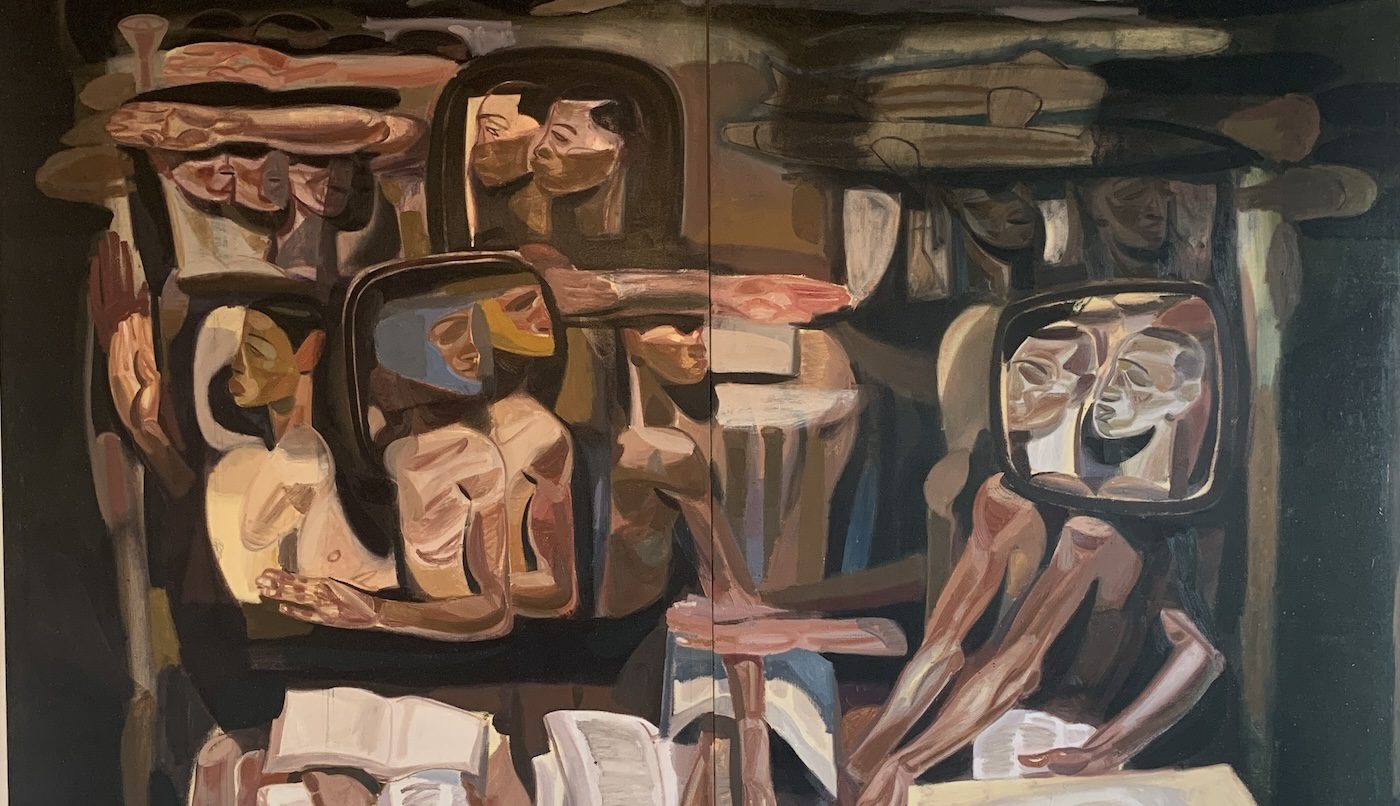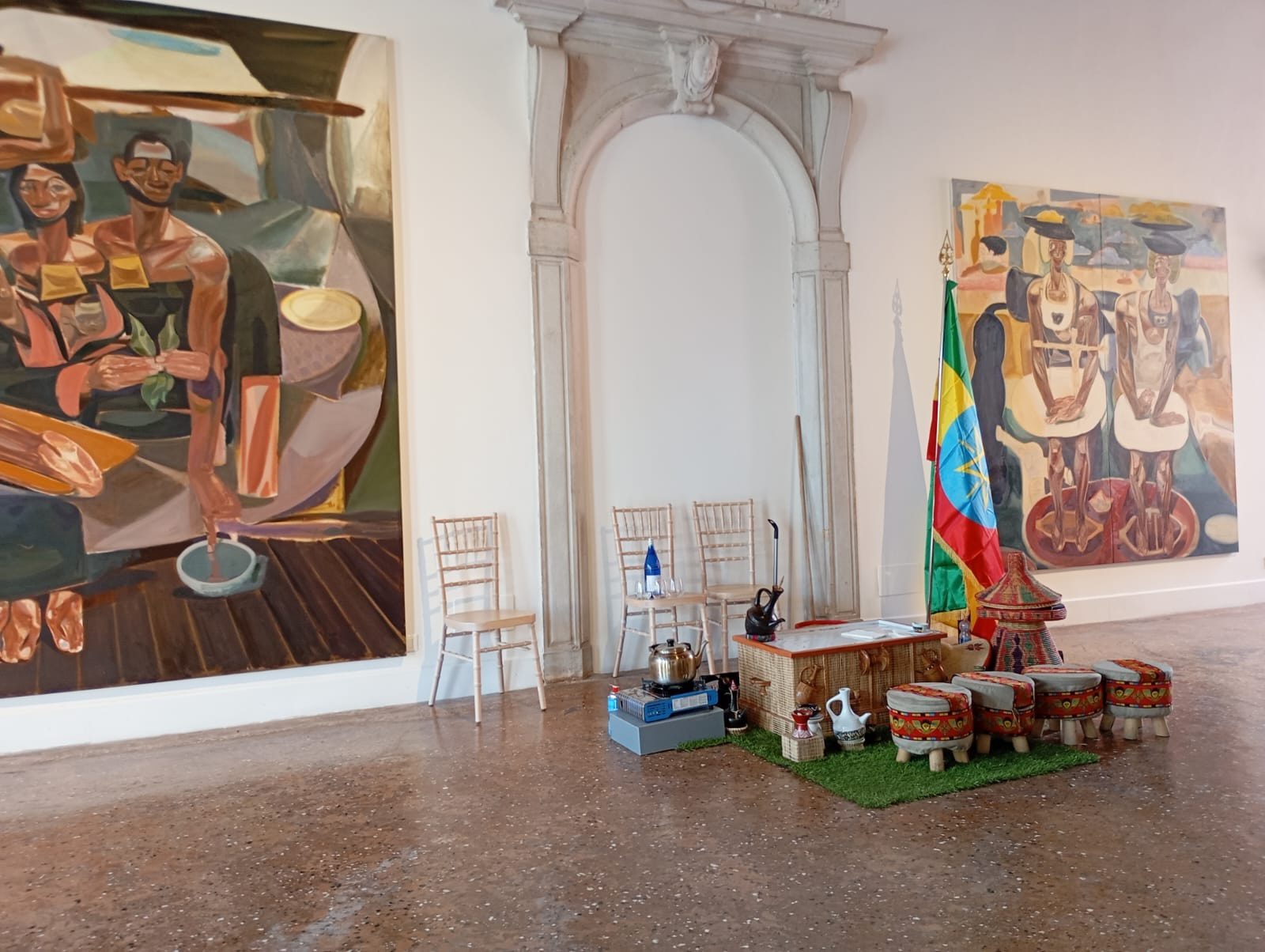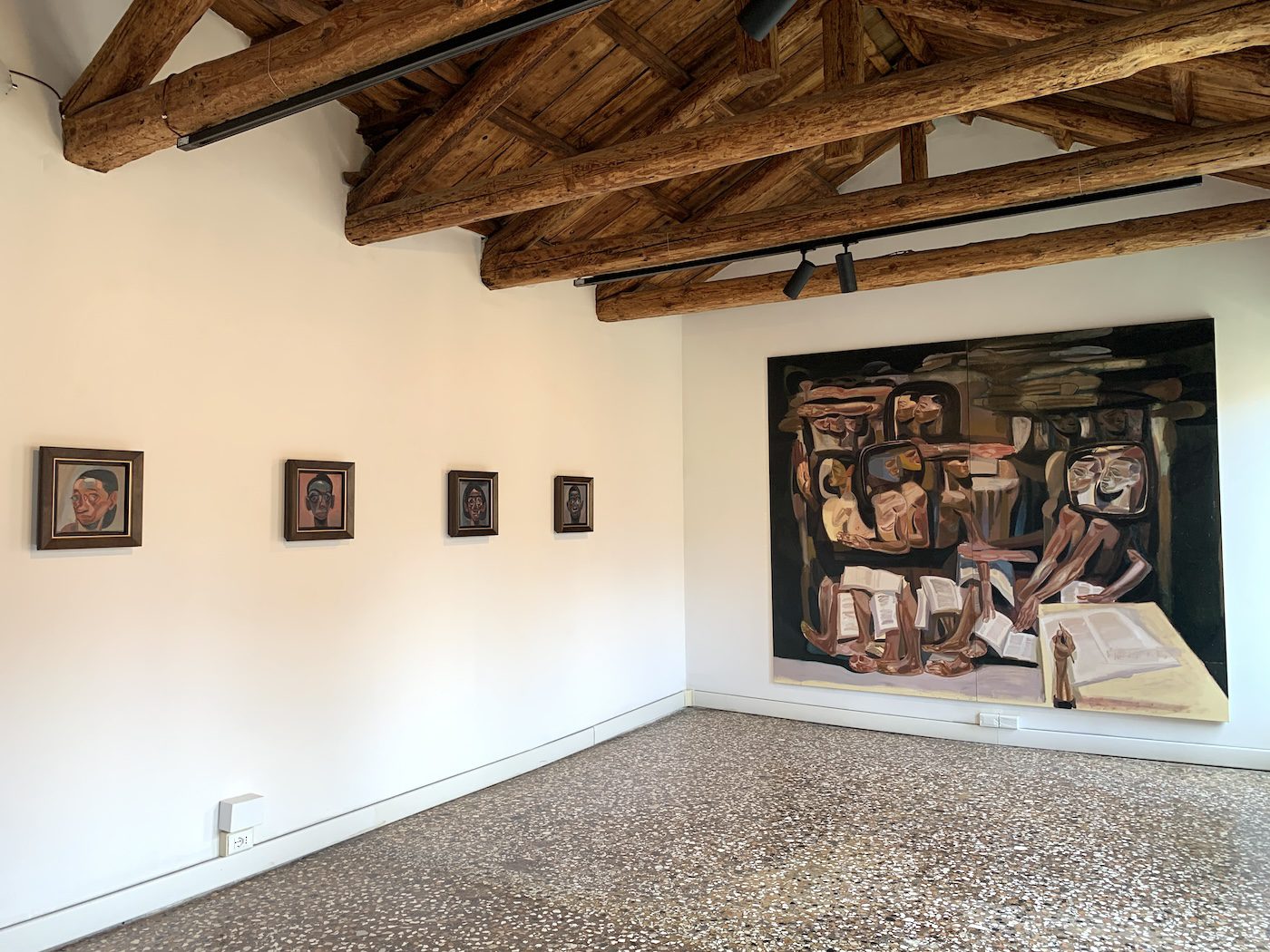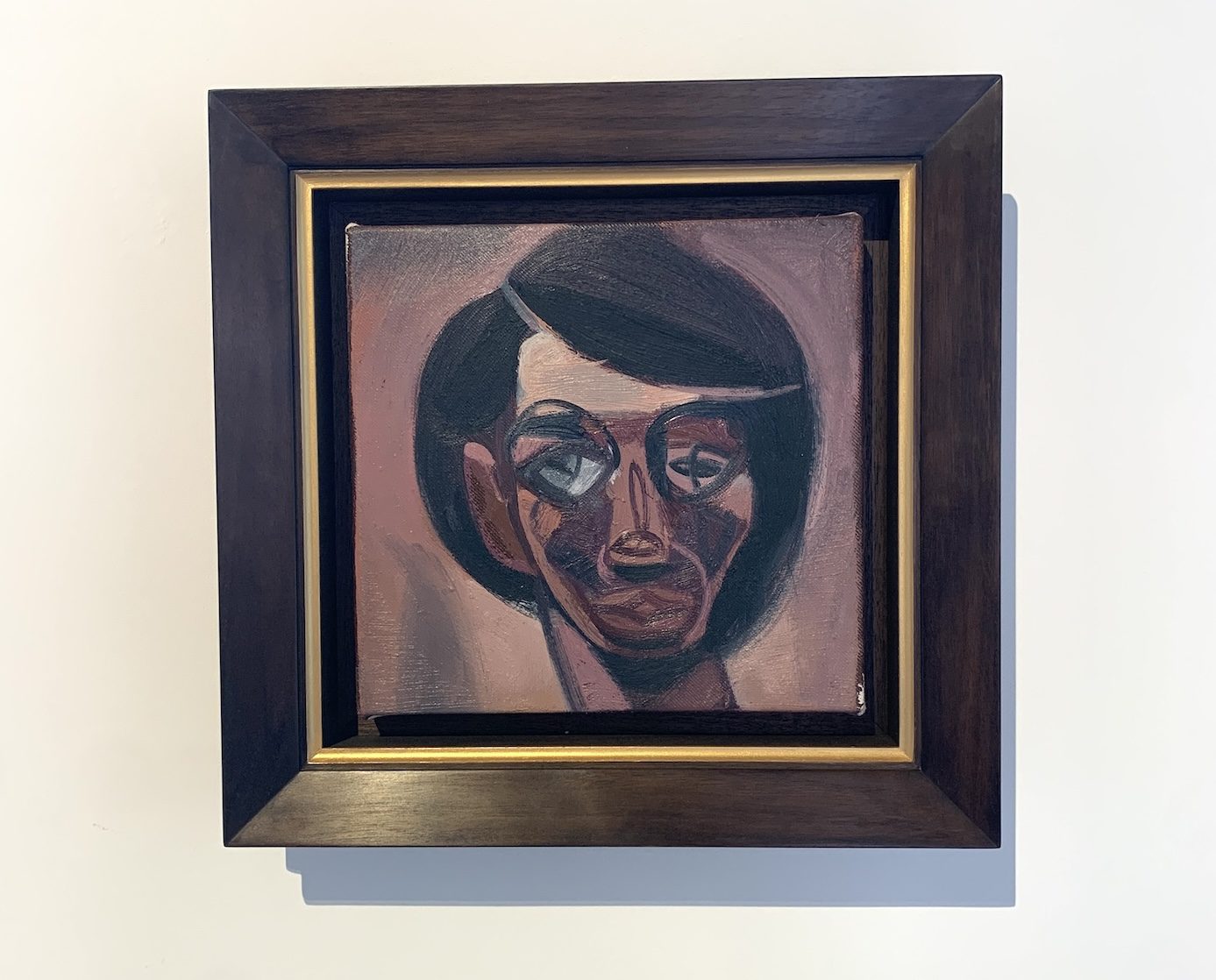For Dagmawit Abebaw Hunz the inaugural pavilion of Ethiopia shines, but also brings up colonial wounds and art-world inequalities.

Tesfaye Urgessa, detail from on of his works of the series "No country for young men", 2019. Installation view at the Ethiopian Pavilion, 60th Venice Biennale. Photo: C&.
አቦል /Abol: Enjoyment
As you enter the main room of the Palazzo Bollani, the scents of coffee and incense fill the air. An Ethiopian coffee ceremony is set up in the center, accompanied by Ethiopian jazz, and Tesfaye Urgessa’s vibrant oil paintings adorn the walls,. At first glance it could be a vernissage in Addis Ababa, but the building and location expose any deceptive sensory impressions. Visitors are offered coffee, starting with አቦል / Abol, the first of the three cups of the Ethiopian coffee ceremony – the cup which is purely for enjoyment and particularly strong.

Ethiopian coffee ceremony is set up in the exhibition. Photo: Dagmawit Abebaw Hunz
The exhibition comprises ten large-format figure paintings and five small-format portraits, distributed harmoniously across three interconnected rooms. Urgessa’s narrative paintings depict fragmented or veiled human figures in domestic settings, blending collage-like group scenes with symbolic and surreal elements. The interplay of colors models elliptical body parts and landscapes to intriguing effect. The oversized canvases fill the rooms, contrasting against the white walls, stucco decorations, bas-reliefs, marble portals, and typical Venetian wooden ceilings. This captivating clash is particularly striking in the last, smaller room where a group of lined-up figures from the series No country for young men (2019) is located. It is an empowering moment.
Urgessa’s artistic intention can be compared to the “wax and gold” (ሰም እና ወርቅ sem-ena-wärq) poetic technique. By using a universal visual language inspired equally by Ethiopian church painting, socialist realism, and the London School, he enables a wide reange of viewers to connect with the figures despite the undefined settings. “I want to invite viewers with my works to put themselves in the shoes of other people’s realities,” he tells me after my visit to the pavilion. “I don’t want to preach to anyone, but rather encourage viewers on a visual level to adopt other perspectives.” Beneath this familiar language, which one can read as the wax layer, lies the golden truth: a call for empathy and humanity. “The figures embody various emotions, from vulnerability to confidence,” he says. “Presenting themselves without judgment despite their scars, they exude strength.” Urgessa hopes to confront the viewers with their own prejudices and reflect on depictions of immigrants’ experiences. Just as Adriano Pedrosa aims to do with his title for this year’s Biennale: Foreigners Everywhere.

Tesfaye Urgessa, Lineage Frost, 2023. Installation view at Ethiopian Pavilion, 60th Venice Biennale. Photo: C&.
ቶና/Tona, the problem talk
As Europe moves ever further to the right with its fascist, dehumanizing border policies, the Biennale is turning the spotlight on migration and decolonization. The main exhibition’s title raises complex questions. While having the potential to give space to marginalized perspectives, it can also evoke tones of everyday racism in Europe.
Independent curator and artist Konjit Seyoum, speaking at an event in the Ethiopian Pavilion, cautioned against viewing the term “foreigner” as a monolithic entity at the Venice Biennale. She emphasized the contrast between the privileged foreigners participating in and visiting the Biennale and the truly invisible foreigners—those struggling with visa issues, residency permits, and discrimination. Seyoum argued that discussing foreignness in the context of the Biennale might seem pretentious when many marginalized individuals lack the privileges associated with this art-world event.
While it is important to celebrate the achievement of a first national pavilion, the occasion also raises many questions. The historical context helps understand the dynamics. Ethiopia’s participation makes visible the often hidden historical links and colonial continuities between Italy and Ethiopia. The brutal Italian occupation from 1935 to 1941 left deep scars in the collective memory of Ethiopians, and one of the symbols of that period is the stolen obelisk from Axum, which was only returned in 2005 – an early case of restitution. The Biennale itself has a history intertwined with Italian fascism, as it came under Benito Mussolini’s control in 1930. This year’s edition is taking place as an Italian government tries to assert its influence with the appointment of right-wing populist Pietrangelo Buttafuoco as Biennale president.

Tesfaye Urgessa, works from the series “No country for young men”, 2019. Installation view at the Ethiopian Pavilion, 60th Venice Biennale. Photo: C&.
Against this tense backdrop, Ethiopia’s Pavilion highlights the remaining colonial legacies and the current political undercurrents surrounding this milestone for the global visibility of Ethiopian art. An Ethiopian proverb says: “ባለቤት ካልተጣራ ጎረቤት አይደርስም” – “Unless you call out, who will open the door?” It means that if you have a problem, you must seek help because no one will come if you don’t, but there are many layers of interpretation. In the context of an international event like the Venice Biennale, it can point to the need for countries and artists to take the initiative to gain visibility and recognition – only those who confidently raise their voices open doors to international acknowledgment and support. Yet the complex reality involves intricate dynamics and challenges. Though he isn’t the first Ethiopian artist at the Biennale, Urgessa establishes a national space with his contemporary paintings, financially supported by the Saatchi Yates Gallery London with cooperation from the Ethiopian government.
In our conversation, Urgessa calls for greater support from the Ethiopian government for artists and the local art scene. He calls for more opportunities and improved infrastructure: “Ethiopia must open its doors and enter into dialogue. This path must be paved, otherwise everything will remain as it has been for the last thirty years.”

By Tesfaye Urgessa. Installation view at the Ethiopian Pavilion, 60th Venice Biennale. Photo: C&.
Urgessa’s presence highlights both the achievement of securing a national pavilion and the ongoing challenges faced by Ethiopian artists in gaining support and recognition, both locally and internationally, in a still white western-dictated art market. But many people are thinking beyond these structures and have long been committed to the local art scene in Addis. Like Konjit Seyoum for instance: “We don’t have the western structure of an art scene, but we have several galleries and art dealers. Many local galleries have come and gone; my Asni Gallery operated for over twenty-three years, supporting young artists. We’re proud of Addis Fine Art Gallery’s international contributions to Ethiopian art, but more support like this is needed. An international gallery alone isn’t enough. Once the door is open for us, we can grow, but we must strengthen our local scene and establish our own rules by developing our own structures.”
One thing is clear, a national pavilion at the Venice Biennale is a step towards greater visibility for Ethiopian artists. And this first pavilion deserves success. However, such visibility remains dependent on ongoing economic, political, and discursive factors. It is crucial that those involved aim to promote Ethiopian art and culture rather than purely seeking commercial gain. Only then can everyone take part in this success.
ባራካ/Baraka – blessings and wishes
I will travel all my life
Excavating the heavenly skies
Bursting open closed doors
Until the non-existent is created
Give me a broad road
Dagmawit Abebaw Hunz is an art historian and art educator, born in Addis and based in Berlin. She holds a master’s degree in art history in a global context from the Free University of Berlin. Her research focuses on decolonial art discourses and the medium of painting in East Africa, particularly in Ethiopia.
60TH VENICE BIENNALE
C&’s second book "All that it holds. Tout ce qu’elle renferme. Tudo o que ela abarca. Todo lo que ella alberga." is a curated selection of texts representing a plurality of voices on contemporary art from Africa and the global diaspora.
More Editorial